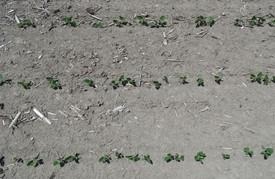By Michael Staton
Many of the soybean acres in Michigan are planted in 15-inch rows using split-row planters. These planters are significantly more expensive than planters of comparable width set up for 30-inch rows and producers want to know if the extra expense is justified. Because of this, the Michigan Soybean On-Farm Research Program conducted eleven trials from 2019 to 2021 to evaluate how these two common row spacings affected soybean yield and income.
Two row spacings (15 inches and 30 inches) were compared at two locations in 2019, six sites in 2020, and three sites in 2021. All trials were planted with planters equipped with interplant/splitter units to ensure that row spacing was the only difference between the treatments. We tried to keep planting rates the same (approximately 130,000 seeds per acre) regardless of row spacing. Stand counts were taken to determine if we achieved this goal.
Final stands for the two row spacings were significantly different at four sites and operator and equipment errors were responsible at two of these. At one site, the guidance system was off, causing some of the 15-inch rows to be planted directly on the previous year’s corn rows. At another site, the planting rate was not adjusted when moving from 15-inch to 30-inch rows. This site provided further evidence that thin soybean stands can produce surprisingly high yields as 57,300 plants per acre produced the same yield as 102,300 plants per acre (66 bushels per acre).

Research results from 66 on-farm soybean planting rate trials can help producers make replant decisions.
READ MORE
The 15-inch rows produced higher yields than the 30-inch rows at four of the eleven sites. When nine of the locations were combined (the two sites with the equipment and operator errors were excluded), the 15-inch rows produced 2.8 bushels per acre more than the 30-inch rows.
Roger Betz, Michigan State University Extension farm management educator, generated a partial budget comparing the economics of purchasing a 12/24 split-row planter versus a 12-row 30-inch planter. This analysis showed that the 15-inch rows increased income by $4,400 per year over the life of the planter. The assumptions used in the analysis are listed below:
- 15% rate of return on investment
- 2.8 bushels per acre yield increase
- Soybean market price of $10 per bushel (10-year projection) minus $0.40 transportation and marketing cost or $9.60 net at the farm.
- 500 acres of soybeans per year
- Planter life of 10 years
- $50,000 higher cost for the interplant planter
- $7500 salvage value
The results from these on-farm research trials show that split-row planters are profitable. However, the yield benefit from planting in narrow rows is reduced when planting early and when planting in high-yielding environments. Also, planting in 30-inch rows is recommended in fields having a history of white mold or that are prone to crusting. Another consideration is that a 30-inch planter can also increase planting capacity by 25% because the price of a 16-row, 30-inch row planter is comparable to that of a 12/24 split-row planter.
A summary of row spacing/planting equipment research conducted in the U.S. is available at: MSU Cropping Systems Agronomy - Soybean.
This article was produced by a partnership between MSU Extension and the Michigan Soybean checkoff.
Source : msu.edu